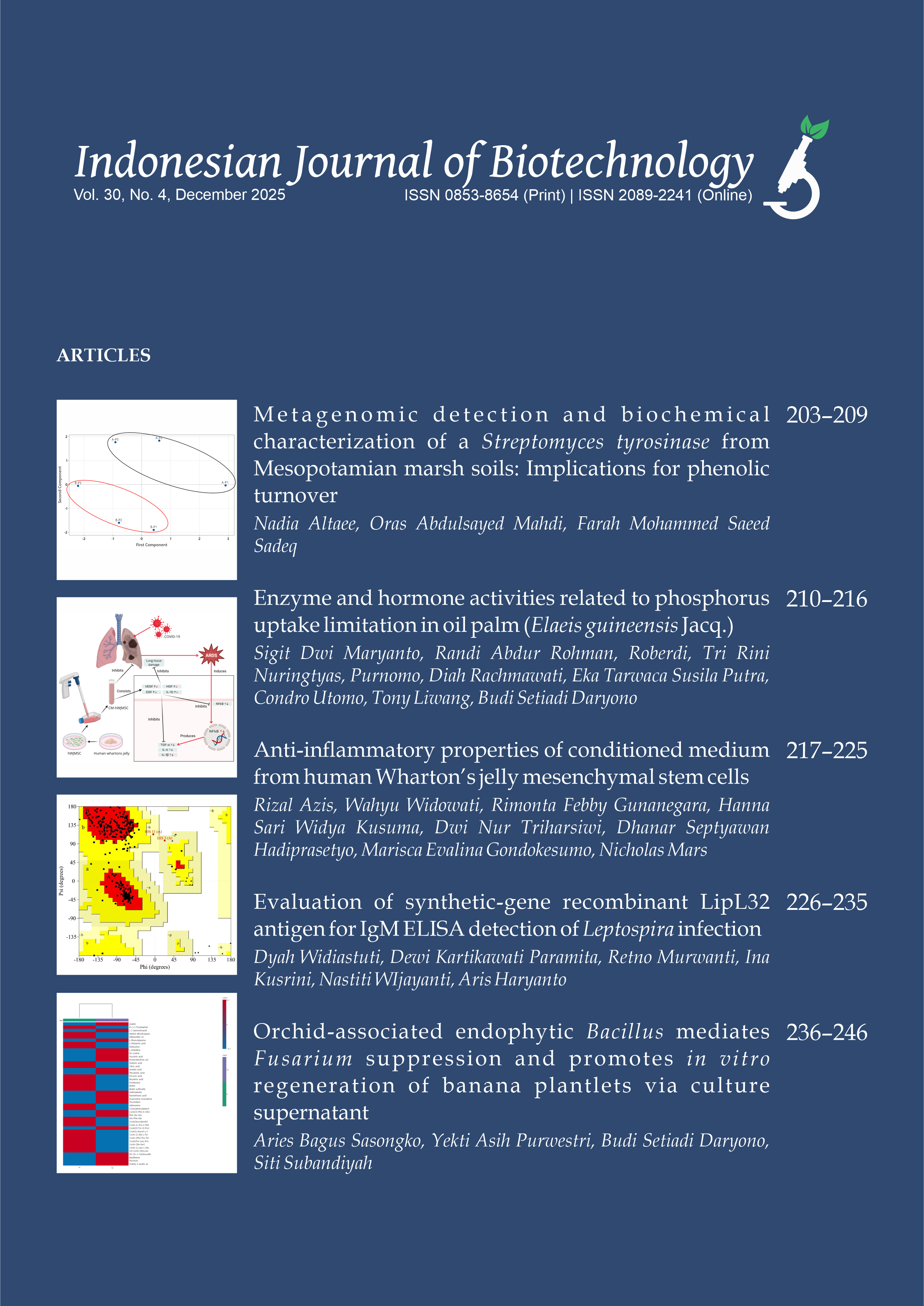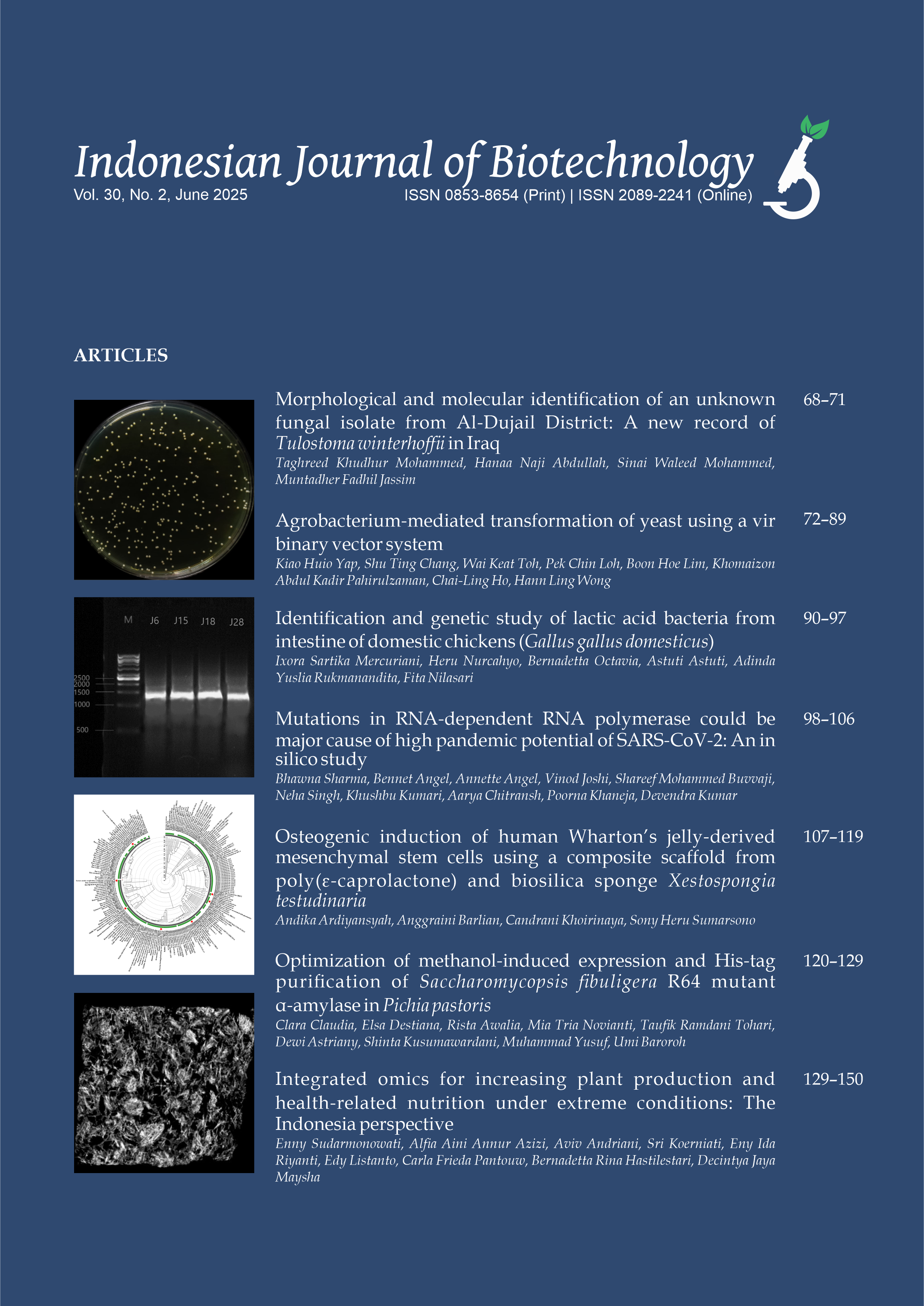In vitro anticancer activity of N-benzyl 1,10-phenanthroline derivatives on human cancer cell lines and their selectivity
Eti Nurwening Sholikhah(1*), Jumina Jumina(2), Sitarina Widyarini(3), Ruslin Hadanu(4), Mustofa Mustofa(5)
(1) Department of Pharmacology & Therapy, Faculty of Medicine, Public Health, and Nursing, Universitas Gadjah Mada, Jalan Farmako, Sekip Utara, Yogyakarta 55281, Indonesia
(2) Department of Chemistry, Faculty of Mathemathics and Natural Sciences, Universitas Gadjah Mada, Sekip Utara, Yogyakarta 55281, Indonesia
(3) Department of Pathology, Faculty of Veterinary Medicine, Universitas Gadjah Mada, Jl. Fauna No. 2, Karang Gayam, Caturtunggal, Depok, Sleman, Yogyakarta 55281, Indonesia
(4) Department of Chemistry Education, Faculty of Teacher Training and Education Science, Pattimura University, Jalan Ir. M. Putuhena, Poka Ambon, Maluku 97234, Indonesia; Department of Chemistry Education, Faculty of Teacher Training and Education Science, Sembilanbelas November Kolaka University, Jalan Pemuda No. 339, Kolaka, Sulawesi Tenggara 93517, Indonesia
(5) Department of Pharmacology & Therapy, Faculty of Medicine, Public Health, and Nursing, Universitas Gadjah Mada, Jalan Farmako, Sekip Utara, Yogyakarta 55281, Indonesia
(*) Corresponding Author
Abstract
This research was conducted to evaluate the anticancer activity of new compounds of benzyl-1,10- phenanthroline derivatives and their selectivity. In vitro anticancer activity of 11 benzyl-1,10-phenanthroline derivatives were conducted on three human cancer cell lines, cervical cancer (HeLa), myeloma (NS-1), and breast cancer (MCF-7) using MTT-based cytotoxicity assay. The cytotoxicity of each compound was assessed to normal Vero cell line by the same method. The in vitro anticancer activity and cytotoxicity was expressed by the concentration inhibiting 50% of the cell growth (IC50), and the selectivity index (SI) was determined by calculating ratio of the IC50 on Vero cell line and the human cancer cell lines. The results showed that among the 11 compounds tested, the (1)-N-(4-butoxybenzyl)-1,10-phenanthrolinium bromide exhibited the best in vitro anticancer activity with an IC50 27.60 ± 2.76 µM on HeLa, 6.42 ± 5.53 µM on NS-1 and 9.44 ± 2.17 µM on MCF-7 cell lines. Its SI were 377.65 ± 39.97 on HeLa, 6158.72 ± 5306.34 on NS-1 and 1140.11 ± 261.85 on MCF-7 cell lines. This study demonstrated that (1)-N-(4-butoxybenzyl)-1,10-phenanthrolinium bromide possessed a potential in vitro anticancer activity on cancer cell lines with high selectivity
Keywords
Full Text:
PDFReferences
Burger AM, Fiebig HH. 2014. Preclinical screening for new anticancer agents. In: MA Rudek, CH Chau, WD Figg, HL McLeod, editors. Handbook of anticancer pharmacokinetics and pharmacokinetics. 2nd edition. New York: Springer. p. 29–45.
Chaston TB, Lovejoy DB, Watts RN, Richardson DR. 2003. Examination of the antiproliferative activity of iron chelators: multiple cellular targets and the different mechanism of action of triapine compared with desferrioxamine and the potent pyridoxal isonicotinoyl hydrazone analogue 311. Clin Cancer Res 9(1 I):402–414.
Coyle B, Kinsella P, McCann M, Devereux M, O’Connor R, Clynes M, Kavanagh K. 2004. Induction of apoptosis in yeast and mammalian cells by exposure to 1,10- phenanthroline metal complexes. Toxicol in Vitro 18(1):63–70. doi:10.1016/j.tiv.2003.08.011.
Darnell G, Richardson D. 1999. The potential of iron chelators of the pyridoxal isonicotinoyl hydrazone class as effective antiproliferative agents III: the effect of the ligands on molecular targets involved in proliferation. Blood 94(2):781–792.
Donfrancesco A, Deb G, Dominici C, Pileggi D, Castello MA, Helson L. 1990. Effects of a single course of deferoxamine in neuroblastoma patients. Cancer Res 50(16):4929–4930.
Duan H, Wang Y, Aviram M, Swaroop M, Loo JA, Bian J, Tian Y, Mueller T, Bisgaier CL, Sun Y. 1999. SAG, a novel zinc RING finger protein that protects cells from apoptosis induced by redox agents. Mol Cell Biol 19(4):3145–3155. doi:10.1128/mcb.19.4.3145.
Dumitraşcu F, Caira MR, Drăghici C, Căproiu MT, Bădoiu A. 2004. Helical chirality of 1-phenacyl-1,10-phenanthrolinium bromides. J Chem Crystallogr 34(9):577–583. doi:10.1023/B:JOCC.0000044083.04054.9d.
Freshney RI. 2000. Culture of animal cells: a manual of basic technique. 4th edition. John Wiley & Sons, Inc. doi:10.1002/9780471747598.
Gao J, Richardson DR. 2001. The potential of iron chelators of the pyridoxal isonicotinoyl hydrazone class as effective antiproliferative agents, IV: the mechanisms involved in inhibiting cell-cycle progression. Blood 98(3):842–850. doi:10.1182/blood.V98.3.842.
Huang X. 2003. Iron overload and its association with cancer risk in humans: Evidence for iron as a carcinogenic metal. Mutat Res, Fundam Mol Mech Mutagen 533(1-2):153–171. doi:10.1016/j.mrfmmm.2003.08.023.
Kemp J, Smith K, Kanner L. 1990. Synergistic inhibition of lymphoid tumor growth in vitro by combined treatment with the iron chelator deferoxamine and an immunoglobulin G monoclonal antibody. Blood 76:991– 995.
Kemp JD, Cardillo T, Kehrberg E, Naumann PW, Kemp JD, Cardillo T, Kemp JD, Weiner G, Kemp JD, Stewart BC, Hedlund B. 1995. Inhibition of lymphoma growth in vivo by combined treatment with hydroxyethyl starch deferoxamine conjugate and igg monoclonal antibodies against the transferrin receptor. Cancer Res 55(17):3817–3824.
Kim BM, Choi JY, Kim YJ, Woo HD, Chung HW. 2007. Desferrioxamine (dfx) has genotoxic effects on cultured human lymphocytes and induces the p53- mediated damage response. Toxicology 229(3):226– 235. doi:10.1016/j.tox.2006.10.022.
Narla RK, Chen Cl, Dong Y. 2001a. In vivo antitumor activity of bis(4,7-dimethyl-1,10-phenanthroline) sulfatooxovanadium(iv) {metvan[vo(so4)(me2- phen)2]}. Clin Cancer Res 7(July):2124–2133.
Narla RK, Dong Y, Cruz OJD, Navara C, Uckun FM. 2000. Bis (4,7-dimethyl-1,10-phenanthroline) sulfatooxovanadium(iv) as a novel apoptosis-inducing anticancer agent 1. Clin Cancer Res 6(2):1546–1556.
Narla RK, Dong Y, Klis D, Uckun FM. 2001b. Bis(4,7- dimethyl-1,10-phenanthroline) sulfatooxovanadium(iv) as a novel antileukemic agent with matrix metalloproteinase inhibitory activity. Clin Cancer Res 7(4):1094–1101.
Nyholm S, Mann GJ, Johansson AG, Bergeron RJ, Graslund A, Thelander L. 1993. Role of ribonucleotide reductase in inhibition of mammalian cell growth by potent iron chelators. J Biol Chem 268(35):26200–26205.
Popiołkiewicz J, Polkowski K, Skierski JS, Mazurek AP. 2005. In vitro toxicity evaluation in the development of new anticancer drugs - Genistein glycosides. Cancer Lett 229(1):67–75. doi:10.1016/j.canlet.2005.01.014.
Richardson D. 2002. Iron chelators as therapeutic agents for the treatment of cancer. Crit Rev Oncol Hematol 42(3):267–281. doi:10.1016/s1040-8428(01)00218- 9.
Sakurai H, Tamura H, Okatani K. 1995. Mechanism for a new antitumor vanadium complex: hydroxyl radicaldependent DNA cleavage by 1,10-phenanthrolinevanadyl complex in the presence of hydrogen peroxide. Biochem Biophys Res Commun 206(1):133–137. doi:10.1006/bbrc.1995.1019.
Sholikhah EN, Mustofa, Miladiyah I, Hadanu R, Tahir I, Jumina, Wijayanti M, Supargiyono. 2007. Cytotoxic activity of /V-alkyl and /V-benzyl 1,10-phenathroline derivatives in human cancer cell lines. J Med Sci 39(01).
Sholikhah EN, Supargiyono, Jumina, Wijayanti MA, Tahir I, Hadanu R, Mustofa. 2006. In vitro antiplasmodial activity and cytotoxicity of newly synthesized N-alkyl and N-benzyl-1,10-phenanthroline derivatives. Southeast Asian J Trop Med Public Health 37(6):1072–1077.
Sun Y. 1997. Induction of glutathione synthetase by 1,10-phenanthroline. FEBS Lett 408(1):16–20. doi:10.1016/S0014-5793(97)00380-3.
Wijayanti MA, Sholikhah EN, Tahir I, Hadanu R, Jumina, Supargiyono, Mustofa. 2006. Antiplasmodial activity and acute toxicity of N-alkyl and N-benzyl-1,10- phenanthroline derivatives in mouse malaria model. J Health Sci 52(6):794–799. doi:10.1248/jhs.52.794.
Yapi AD, Mustofa M, Valentin A, Chavignon O, Teulade JC, Mallie M, Chapat JP, Blache Y. 2000. New potential antimalarial agents: synthesis and biological activities of original diaza-analogs of phenanthrene. Chem Pharm Bull 48(12):1886–9. doi:10.1248/cpb.48.1886.
Article Metrics
Refbacks
- There are currently no refbacks.
Copyright (c) 2018 The Author(s)

This work is licensed under a Creative Commons Attribution-ShareAlike 4.0 International License.









